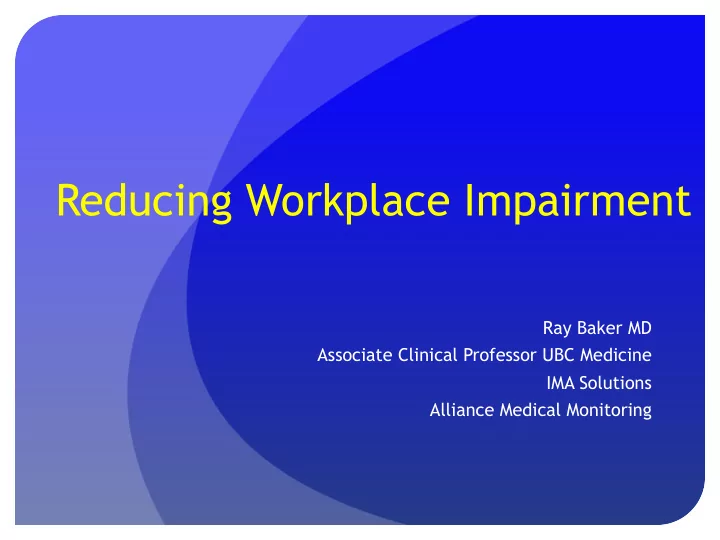

Reducing Workplace Impairment Ray Baker MD Associate Clinical Professor UBC Medicine IMA Solutions Alliance Medical Monitoring
Points Addiction: chronic brain disorder Detecting workplace impairment Remission/recovery? The evidence The mentally healthy/safe workplace and substance use disorders
10 % of employees will experience a substance use disorder (NIDA – 2009) [This number could double with DSM 5 criteria] Substance use disorder is second highest prevalence mental health diagnosis in Canada Addictions mimic mental disorders: (depression, stress-related conditions, anxiety, panic, bipolar, psychosis)
The Nature of Addictions Addictions are self inflicted. People with addictions misbehave. They are too weak to control their impulses. If they just changed their behaviours and lifestyle they’d be fine. Yep, just like other genetically influenced chronic progressive diseases: type 2 diabetes, coronary heart disease, morbid obesity and many types of cancer
Neurobiology of Addiction
Addictions: ASAM/CSAM chronic progressive brain disorder Addiction: a primary, chronic disease of brain reward, motivation, memory and related circuitry. Dysfunction in these circuits leads to characteristic biological, psychological, social and spiritual manifestations. This is reflected in an individual pathologically pursuing reward and/or relief by substance use and other behaviors.
Alcohol & Drug Use Dependence Zero Regular Abuse Early Mid-stage use Use Late 65% 5-10% 20% “ Pickle Line ” Workplace becomes aware
Treatment Intensity? Most people with addictive disorders find help and get well (EFAP , counsellor, AA, church, etc.) before it affects the workplace By the time addiction affects workplace attendance performance behaviour or safety the disorder is at a later more severe stage and the person has failed prior attempts to control/treat the problem
Behaviours Isolation & social withdrawal Forgetting previous conversations Irritability & mood swings Mood changes after breaks Angry outbursts & interpersonal conflict Defensiveness, blaming Unreasonable resentment Increased absenteeism, lateness & schedule confusion
Employer Dilemma (multilemma?) Civil/criminal Liability Employee privacy rights Duty to accommodate employees with disabilities Duty to provide mentally safe workplace Performance management
Drug Testing? Substances are far from commonest cause of impairment Do employers perform other medical investigations to detect diabetes, seizure disorder, narcolepsy etc? Drug testing does not prove impairment (except brthlzr) The question to answer: Is this worker fit to safely work?
Occupational Addiction Medicine Evaluation BIO Multiple Treatment/ Diagnoses Relapse prevention Plan
Evidence
Evidence Substance dependent physicians medically monitored using contingency management techniques achieve rates of long- term stable abstinent remission greater than 80%
Long-Term Recovery What happens after “treatment” much more important than what happens during “treatment” Spend resources accordingly
Contingency Management Sustains motivation to adhere to relapse prevention plan Links benefits to adherence to treatment plan The single most important predictor of successful recovery
Medical Monitoring Essential for reinstatement of personnel with disorders for which high relapse risk is likely to endanger workplace or public safety Monitor records/reports 1. adherence to relapse prevention plan 2. abstinent remission
The Safe and Healthy Workplace: Will implement National Standard on Psychological Health and Safety in the Workplace (CMHA) Will train personnel on its substance use/ substance use disorder policy Will ensure risk sensitive employees receive effective treatment and relapse prevention, contingency management and medical monitoring
Summary Addictions: common chronic progressive brain disorders with biopsychosocial/ spiritual symptoms Comprehensive, long-term treatment based on thorough diagnostic evaluation results in high recovery rates The workplace can be the most effective resource in helping personnel with addictive disorders
Recommend
More recommend